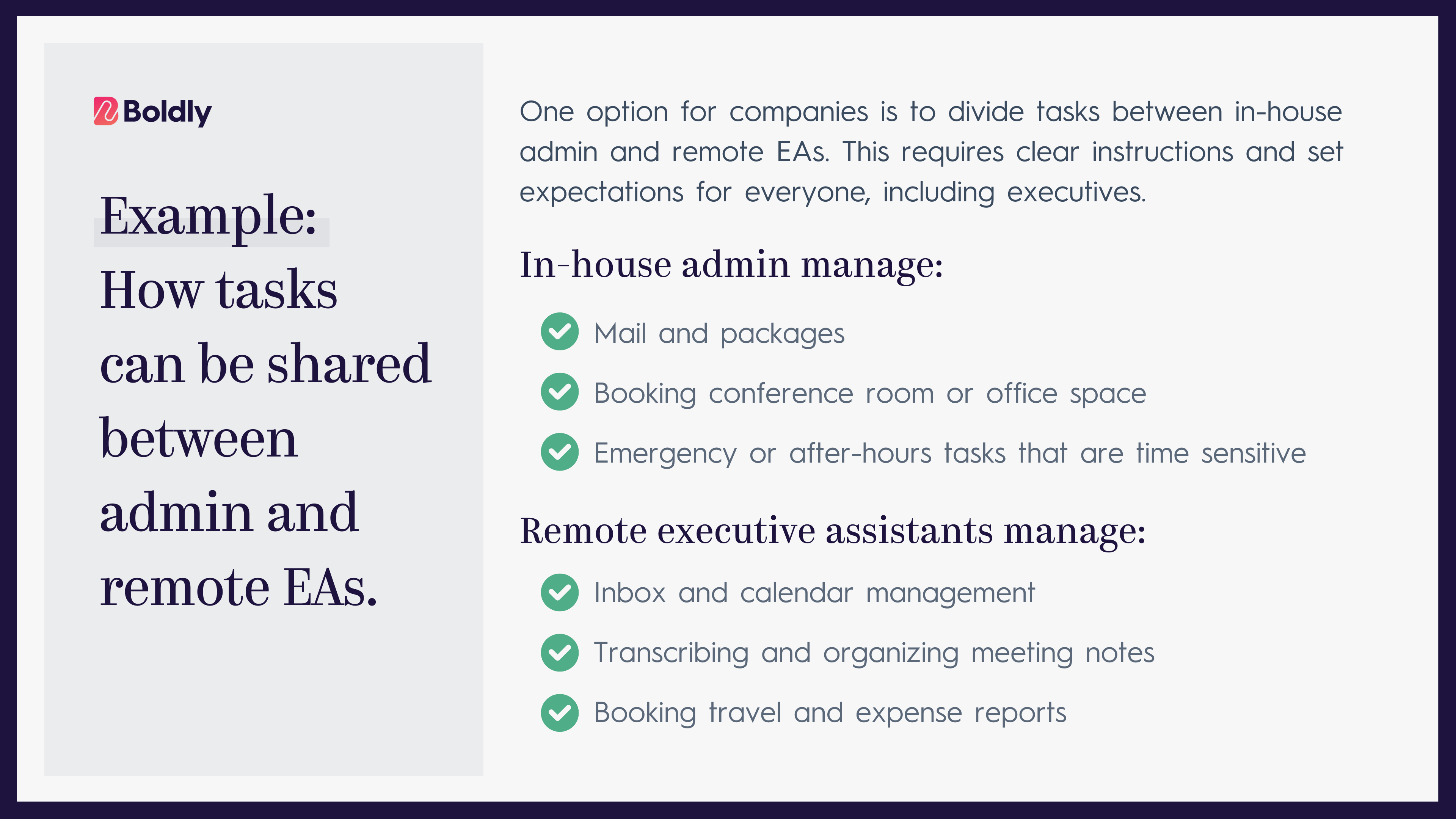This isn’t a question of replacing your current in-house admin team. It’s about complementing it.
Adding supplemental help in the form of a remote executive assistant (or even multiple remote EAs!) is a game-changer.
We’ll show you why, starting with a few examples of how companies can bring together remote and in-house teams to meet their administrative needs.
Seamlessly Integrating A Remote Executive Assistant With Your Team
At Boldly, we have a track record of seamlessly integrating our remote executive assistants with client teams.
Successful remote work relationships are our standard. We know that each client is unique, and so we don’t take a one-size-fits-all approach. We’re also experts on offering both clients and our EAs support on the best way to maintain a remote working relationship.
There’s no one way to use a remote EA with your in-house admin team, though over the years, we’ve noticed several ways our enterprise clients tend to use remote executive assistants. In general:
- Remote EAs can work directly with the admin team to take on overflow work, or
- Remote EAs can directly support executives, teams, or departments, with in-house admin leading on on-site tasks, time-sensitive, or last-minute requests.
Overlapping duties between remote and in-house EAs.


Some clients rely mostly on our remote executive assistants and only use the in-house admin team as a backup. Others more directly integrate both the in-house and remote team members, using in-house EAs to handle time-sensitive or last-minute requests, as well as all tasks that require someone in-person. They use remote EAs to handle the “overflow” work.
With either approach, there is overlap as the remote EA and in-house team are sharing the same work for the same executives.
The best way to integrate with the overlapping model is to:
- Establish expectations for both in-house and remote EAs that are the same or in tandem.
- Define limits of what a remote EA should do.
- Communicate frequently, especially at the beginning, to make sure no one is stepping on toes or doubling up on work.
Exclusively assigning EAs to specific executives.
Other clients take a different approach, assigning a remote EA to a specific person and using the in-house and remote team members in an identical manner.
In this scenario, there is little overlap in duties among the EAs since they are dedicated to one or more executives and handle all the work associated with that executive. Remote EAs will handle the same work as in-house EAs, including sensitive work or high-level access.
This is going to require that executives have a high trust-factor with a remote EA. It also works best if in-house or in-person requirements for the EA are low or none.
The best way to put this model to work is to:
- Establish expectations on availability, output, security, and privacy.
- Have a plan for who will do in-person tasks for the remote executive assistant.
- Make sure the remote EA has necessary access to information and tools to successfully do the job.
Using remote EAs to build in-house staff.
Some clients use our remote EAs as a safeguard or to help train and support in-house staff.
When new in-house EAs are hired, they work closely with an experienced remote EA for a while, particularly with scheduling and expenses, until they get the lay of the land.
While this is less common, this model works best if you remember that future executive assistants are going to mimic what they learn and that the remote executive assistant should be fluent in how your company functions.
Three Ways Remote EAs Can Help Your Admin Team
So why turn to remote executive assistants in the first place?
The need for more staff is solved by either going through the hiring process, which is time-consuming and expensive, or turning to a remote executive assistant.
Remote executive assistants complement your team, unlocking potential in three ways.
1. They enhance efficiency and productivity, making growth positive.
Here’s the problem: you have more work than people to do it. Growth opportunities are wonderful, unless you don’t have the human capital to handle them.
Remote executive assistants create the opportunity to be flexible and scale, making it possible to take advantage of growth opportunities. They not only come on board without the time and expense of hiring another employee, but they pack a powerful set of skills, and they’ll put them to work for you quickly.
Even if you only ask your remote EA for a handful of hours a week, you’ll start to see big strides in executive productivity.
2. They make room for creative solutions.
While improving productivity is important, there’s more to an effective team than how much work they can accomplish.
Creativity is the ability to come up with solutions by making unique connections across ideas, methods, and platforms. When problems pop up or deadlines loom, it’s creativity that gets us through.
Yet studies have shown that 75% of workers are pressured to be productive, not creative. 80% believe that valuing and encouraging creativity is crucial to economic growth, so clearly there’s a necessary balance.
Here’s the thing: an overworked admin team (or an executive team overloaded with admin) doesn’t have a lot of room for creativity.
Creative thinking takes space. Being busy doesn’t provide enough of that space. Your team has great potential but they’re simply focused on trying to stay ahead of the curve and get the daily work done.
Remote EAs help release the potential locked away in your in-house administrative team. Drop a remote executive assistant in the mix, with their own fresh perspective, and they have the potential to free up creative space by taking on the extra work. You’ll supercharge your administrative team’s creative problem-solving power.
3. They improve work-life balance for your team.
Work-life balance isn’t a buzzword, it’s a real concern.
When 55% of employees admit to having unused vacation days left at the end of the year, and nearly half of all workers consider themselves workaholics, there’s a work-life balance problem. Your team isn’t exempt.
Work-life balance for remote employees is its own struggle, but pairing remote executive assistants with your in-house team is a winning combination, not a compounding problem. How?
The key word is balance.
A remote executive assistant is taking on some of the weight of the work to balance the scale. They can cover for your in-house team and reduce required overtime, or allow for time-off instead of racking up vacation days that never get used.
A remote worker doesn’t have a commute and might even be in a different time zone; it’s possible your in-house team can leave early some days to spend time with their families knowing the remote executive assistant is covering for them.
The Best Way To Start With A Remote Executive Assistant
So, which is the best way to integrate a remote executive assistant? Should you overlap duties? Assign a remote EA to a specific executive? Use them as needed and to help train in-house admin teams?
A discussion with your in-house admin team is a great place to start.
Find out what they need help with. Talk to executives and discover their pain points. But regardless of what you find, the best way is to start today.
By the time you’re feeling the pinch of needing more help, the problem is overdue for a solution.
We’ve had success placing remote executive assistants not just because of our careful attention to finding the right EA for the client, but because we have a proven system that quickly and easily has you up and running within days.
And, as you begin working with a remote EA, you’ll find that their role and how you’ll integrate them into your in-house team will become more apparent.




